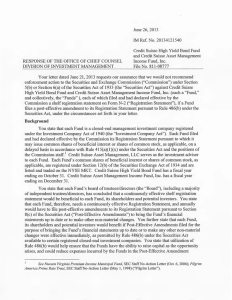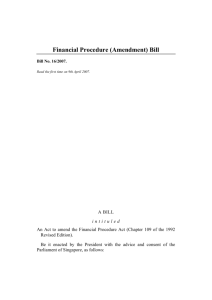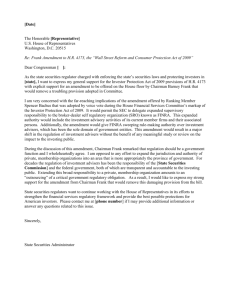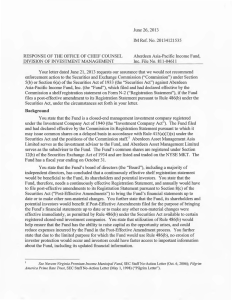June 26, 2013 IM Ref. No. 20134121538 First Trust Strategic High Income
advertisement
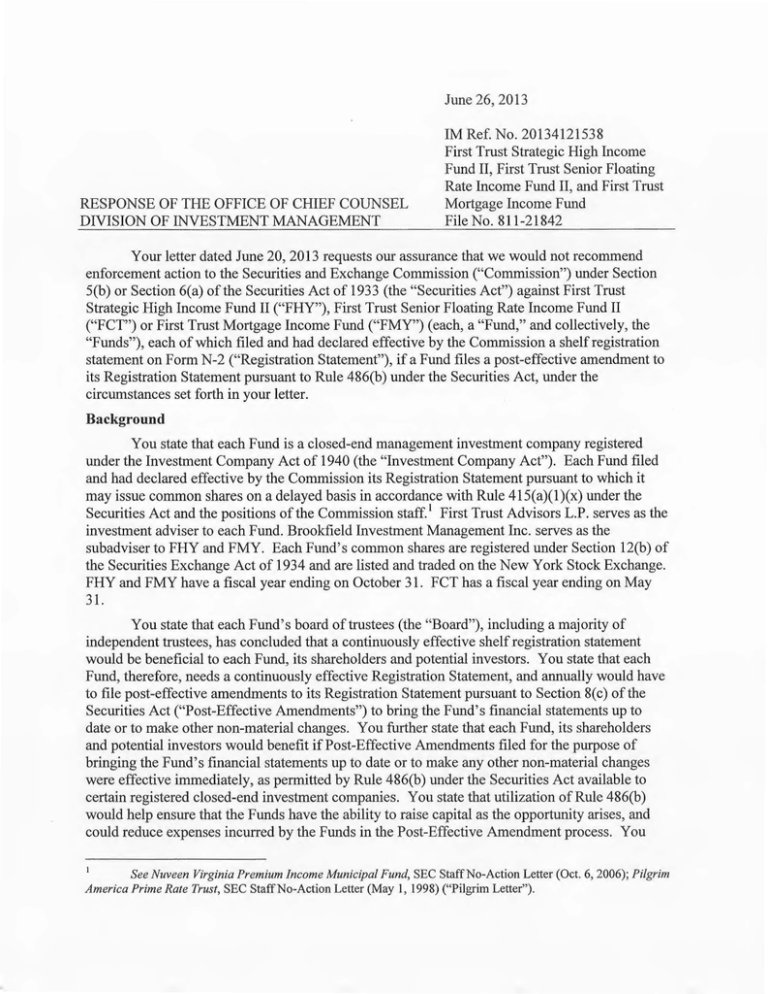
June 26, 2013 RESPONSE OF THE OFFICE OF CHIEF COUNSEL DIVISION OF INVESTMENT MANAGEMENT IM Ref. No. 20134121538 First Trust Strategic High Income Fund II, First Trust Senior Floating Rate Income Fund II, and First Trust Mortgage Income Fund File No. 811-21842 Your letter dated June 20,2013 requests our assurance that we would not recommend enforcement action to the Securities and Exchange Commission ("Commission") under Section 5(b) or Section 6(a) of the Securities Act of 1933 (the "Securities Act") against First Trust Strategic High Income Fund II ("FHY"), First Trust Senior Floating Rate Income Fund II ("FCT") or First Trust Mortgage Income Fund ("FMY") (each, a "Fund," and collectively, the "Funds"), each of which filed and had declared effective by the Commission a shelf registration statement on Form N-2 ("Registration Statement"), if a Fund files a post-effective amendment to its Registration Statement pursuant to Rule 486(b) under the Securities Act, under the circumstances set forth in your letter. Background You state that each Fund is a closed-end management investment company registered under the Investment Company Act of 1940 (the "Investment Company Act"). Each Fund filed and had declared effective by the Commission its Registration Statement pursuant to which it may issue common shares on a delayed basis in accordance with Rule 415(a)(1)(x) under the Securities Act and the positions of the Commission staff. 1 First Trust Advisors L.P. serves as the investment adviser to each Fund. Brookfield Investment Management Inc. serves as the subadviser to FHY and FMY. Each Fund's common shares are registered under Section 12(b) of the Securities Exchange Act of 1934 and are listed and traded on the New York Stock Exchange. FHY and FMY have a fiscal year ending on October 31. FCT has a fiscal year ending on May 31. You state that each Fund's board oftrustees (the "Board"), including a majority of independent trustees, has concluded that a continuously effective shelf registration statement would be beneficial to each Fund, its shareholders and potential investors. You state that each Fund, therefore, needs a continuously effective Registration Statement, and annually would have to file post-effective amendments to its Registration Statement pursuant to Section 8(c) of the Securities Act ("Post-Effective Amendments") to bring the Fund's financial statements up to date or to make other non-material changes. You further state that each Fund, its shareholders and potential investors would benefit if Post-Effective Amendments filed for the purpose of bringing the Fund's financial statements up to date or to make any other non-material changes were effective immediately, as permitted by Rule 486(b) under the Securities Act available to certain registered closed-end investment companies. You state that utilization of Rule 486(b) would help ensure that the Funds have the ability to raise capital as the opportunity arises, and could reduce expenses incurred by the Funds in the Post-Effective Amendment process. You See Nuveen Virginia Premium Income Municipal Fund, SEC Staff No-Action Letter (Oct. 6, 2006); Pilgrim America Prime Rate Trust, SEC StaffNo-Action Letter (May I, 1998) ("Pilgrim Letter"). further state that due to the limited purposes for which the Funds would use Rule 486(b), no erosion of investor protection would occur and investors could have faster access to important information about the Funds, including their updated financial information. Discussion Rule 486(b) under the Securities Act, in relevant part, states that a post-effective amendment to a registration statement filed by a registered closed-end management investment company which makes periodic repurchase offers under Rule 23c-3 under the Investment Company Act ("Interval Fund") shall become effective on the date on which it is filed with the Commission, provided that certain conditions are met. The conditions of Rule 486(b) require, among other things, that the post-effective amendment be filed for no purpose other than, among other things, bringing the financial statements up to date or making non-material changes, and that the registrant make certain representations concerning the purpose for which the amendment is filed. In adopting Rule 486(b) in 1994, the Commission recognized that Interval Funds may have a need to raise capital continuously, and therefore need continuously effective registration statements and would benefit if certain filings could become effective automatically. 2 The Commission staff in 1998 recognized that registered closed-end management investment companies such as the Funds, which are not Interval Funds, also may benefit from the flexibility to take advantage of favorable market conditions to raise additional capital through continuous or delayed offerings of their securities. 3 You assert that the Funds and their shareholders also would benefit if the Funds' Post-Effective Amendments that comply with the conditions of Rule 486(b) could become effective immediately pursuant to that Rule. You represent that each filing made in reliance on the requested relief would be made in compliance with the conditions of Rule 486(b), and that each Fund will file a Post-Effective Amendment containing a prospectus pursuant to Section 8(c) of the Securities Act prior to any offering of its common shares at a price below net asset value. You also represent that in relying on the requested relief to sell common shares, each Fund will sell newly issued shares at a price no lower than the sum ofthe Fund's net asset value plus the per share commission or underwriting discount. 4 Conclusion Based on the facts and representations set forth in your letter, we would not recommend that the Commission take any enforcement action under Section 5(b) or Section 6(a) ofthe Securities Act against the Funds if the Funds file Post-Effective Amendments to their 2 See Post-Effective Amendments to Investment Company Registration Statements, Investment Company Act Release No. 20486 (Aug. 17, 1994), n.22 and accompanying text. An Interval Fund operates pursuant to a fundamental policy that requires the Interval Fund to make periodic offers to repurchase its common stock in an amount not less than five percent of the outstanding shares. See Rule 23c-3 under the Investment Company Act. These repurchase offers may create a need for the Interval Fund to replenish its assets by making a continuous or intermittent offering of its common stock. See Continuous or Delayed Offerings by Certain Closed-End Management Investment Companies; Automatic Effectiveness of Certain Registration Statements and Post-Effective Amendments, Investment Company Act Release No. 19391 (Apr. 7, 1993). S ee Pilgrim Letter, supra note 1, at n .12 and accompanying text. 4 See Pilgrim Letter, supra note I , at n.4 and accompanying text. 2 Registration Statements pursuant to Rule 486(b) under the Securities Act. This response expresses our view on enforcement action only and does not express any legal or interpretive conclusion on the issues presented. Because our position is based upon all of the facts and representations in your letter, any different facts or representations may require a different conclusion. 5 We note that each Fund has acknowledged that the staff may withdraw any assurance granted in this letter if the staff finds that the Fund is misusing Rule 486(b) or for any other reason. (h._,~~\ Adam Glazer Senior Counsel The Division oflnvestment Management generally permits third parties to rely on no-action or interpretive letters to the extent that the third party's facts and circumstances are substantially similar to those described in the underlying request for a no-action or interpretive letter. See Informal Guidance Program for Small Entities, Investment Company Act Release No. 22587 (Mar. 27, 1997), n.20. In light of the very fact-specific nature of the Funds' request, however, the position expressed in this letter applies only to the Funds, and no other entity may rely on this position. The staff is willing to consider similar requests from other registered closed-end management investment companies. 3 Chapman and Cutler LLP Attorneys at Law . Focused on Finance' June 20, 2013 Division of Investment Management United States Securities and Exchange Commission 100 F Street, N.E. Washington, DC 20549 Attn: Ms. Nadya B. Roytblat Re: First Trust Funds and Rule 486(b) Dear Ms. Roytblat: On behalf of First Trust Strategic High Income Fund II ("FHY"), First Trust Senior Floating Rate Income Fund II ("FCT") and First Trust Mortgage Income Fund ("FMY" and together with FRY and FCT, the "Funds" and each, a "Fund") we seek assurance that the Staff of the Division of Investment Management (the "Staff') wil not recommend enforcement action against the Funds to the Securities and Exchange Commission (the "Commission") under Section 5 or Section 6(a) of the Securities Act of 1933, as amended (the "Securities Act") if the Funds utilize Rule 486(b) of the Securities Act, under the circumstances set forth in this letter. Background FHY, FCT and FMY are each a closed-end management investment company registered under the Investment Company Act of 1940 (the "Investment Company Act"). First Trust Advisors L.P. ("FTA") serves as the investment adviser to the Funds. FMY and FRY have a fiscal year ending October 31 and FCT has a fiscal year ending May 31. Brookfeld Investment Management Inc. serves as the sub-adviser to each of FHY and FMY, with the primary responsibility for the day-to-day supervision and investment strategy of FHY and FMY. FT A's Senior Loan Team is responsible for the day-to-day supervision and investment strategy of FCT. Each Fund's common shares are registered under Section 12(b) of the Securities Exchange Act of 1934 and each of the Funds has been listed and traded on the New York Stock Exchange since the respective Fund's inception. Each Fund has filed and had declared effective by the Commission a shelf registration statement on Form N-2, pursuant to which each Fund issued shares of common stock in accordance with Rule 415(a)(1)(x) of the Securities Act, consistent with the positions of the Staff articulated in Pilgrim America Prime Rate Trust (pub. avaiL. May 1, 1998) and Nuveen Virginia Premium Income Municipal Fund (pub. avaiL. October 6, 2006). The Commission initially declared effective FR's Form N-2 shelf registration statement (File Nos. 333-180240; 811-21842) on May 31, 2012, FMY's Form N-2 shelf registration Chicago New York Salt Lake City San Francisco Washington, DC 3225448.01. 1. doc 0000204 Chapman and Cutler LLP Ms. Nadya B. Roytblat June 20,2013 Page 2 statement (File Nos. 333-170228; 811-21727) on June 15, 2012 and FCT's Form N-2 shelf registration statement (File Nos. 333-184182; 811-21539) on November 16,2012. The Board of Trustees (the "Board") of each Fund, including each of their respective independent trustees, has concluded that the continued ability to raise capital through the public offering of additional shares of common stock on a delayed and continuous basis is of great benefit to each Fund, their shareholders and potential investors. However, the Funds' shelf registration statements may not be continuously effective due to the post-effective amendment process currently implemented by the Commission, which requires the Commission to review and declare effective any post-effective amendments filed to a shelf registration statement in order to bring the Funds' financial statements up to date. The Board of each Fund, including each of their respective independent trustees, believes that the Funds, their shareholders and potential investors would benefit if the Funds were permitted to utilize Rule 486(b) under the Securities Act to file post-effective amendments to their shelf registration statements to bring their financial statements up to date that would become effective immediately upon filing with the Commission. Discussion Rule 415(a)(3) of the Securities Act requires a registrant that is an investment company filing on Form N-2 (the registration statement utilized by closed-end funds) to furnish the undertakings required by Item 34.4 of Form N-2. Item 34.4.a of Form N-2 requires a registrant to undertake "to file, during any period in which offers or sales are being made, a post-effective amendment to the registration statement: (l) to include any prospectus required by Section 1O(a)(3) of the 1933 Act." Each Fund has made this undertking in its effective registration statement. As a consequence, each Fund currently is required to fie a post-effective amendment on an annual basis to update its shelf registration statement with its audited financial statements in accordance with this undertaking, as well as to make any non-material updates. Each Fund currently is required to satisfy this undertaking by fiing a post-effective amendment with the Commission pursuant to Section 8(c) of the Securities Act. Section 8(c) does not provide a mechanism for automatic effectiveness. A post-effective amendment filed pursuant to Section 8(c) must be declared effective by the Staff in order to take effect. This process subjects the post-effective amendment to review and comment by the Staff, including for routine non-material amendments. Prior to the post-effective amendment being declared effective by the Staff, a Fund cannot issue common shares of beneficial interest pursuant to it, thereby potentially preventing the Fund from taking advantage of what may be an attractive market to raise capital for the benefit of Fund shareholders. Chapman and Cutler LLP Ms. Nadya B. Roytblat June 20,2013 Page 3 Closed-end funds that are operated as interval funds pursuant to Rule 23c-3 under the Investment Company Act are not subject to these delays. Rule 486(b) generally provides that a post-effective amendment to a registration statement, or a registration statement for additional shares of common stock, filed by a registered closed-end management investment company or business development company which makes periodic repurchase offers under Rule 23c-3 of the Investment Company Act (collectively, "Interval Funds") shall become immediately effective on the date it is fied, or on a later date designated by the registrant that is no more than 30 days after the fiing is made, provided that the post-effective amendment or registration statement is filed solely (i) to register additional shares of common stock for which a registration statement filed on Form N-2 is effective, (ii) to bring the financial statements up to date under Section 10(a)(3) of the Securities Act or Rule 3-18 of Regulation S-X, (iii) to designate a new effective date for a previously filed post-effective amendment or registration statement for additional shares under Rule 486(a), which has not yet become effective, (iv) to disclose or update the information required by Item 9c of Form N-2; (v) to make any non-material changes the registrant deems appropriate, and (vi) for any other purpose the Commission shall approve. In the adopting release for Rule 486 (Release NO.333-7083 & IC-20486), the Commission stated that "(t)he initial proposal of rule 486 recognized that closed-end interval funds may need continuously effective registration statements and would benefit if certain filings could become effectively automatically." As closed-end funds that are conducting offerings pursuant to Rule 415(a)(1)(x), the Funds believe that Rule 486 should be extended to them. The Funds believe that, like Interval Funds, the Funds, their common shareholders and potential investors would also benefit from having continuously effective registration statements. The benefits of the Funds' ability to use Rule 486(b) in order to maintain a continuously effective registration statement include: . ensuring that the Funds have the ability to raise capital if the opportunity arises; . reducing expenses incurred by the Funds and the Commission as a result of the registration statement review and comment process; and . providing investors with faster availability of the Funds' financial statements. Due to the limited purposes for which the Funds could use Rule 486(b), the Funds believe that the Commission's public policy to protect investors would not be compromised. Furthermore, offerings by the Funds of their common stock pursuant to their respective shelf registration statements are subject to Section 23(b) of the Investment Company Act, which generally requires that the public offering price of common shares of a closed-end investment company (exclusive of distribution commissions and discounts) equal or exceed the net asset value per share of the Funds' common shares (calculated within 48 hours of pricing), absent shareholder approval or under certin other circumstances. Each of the Funds has specified in its shelf registration statement that the public offering price of the Fund's common shares offered Chapman and Cutler LLP Ms. Nadya B. Roytblat June 20,2013 4 Page pursuant to its shelf registration statement will be equal to or in excess of the net asset value per share of the Fund's common shares (exclusive of distribution commissions and discounts) as specified in Section 23(b) of the Investment Company Act) The Funds represent that at the time of each post-effective amendment filing, such filings will be made in compliance with the conditions of Rule 486(b), and the Funds will comply with each of the undertkings currently found in their respective currently effective shelf-registration statements. We recognize that the Staff has previously granted No-Action relief to certain registered closed-end management investment companies seeking to utilize Rule 486(b) to amend their shelf registration statements.2 We understand that the No-Action relief granted in the Prior No-Action Letters apply only to the funds referenced in the Prior No-Action Letters and no other entity may rely on the relief. However, the Prior No-Action Letters state that the Staff is wiling to consider similar requests. We believe the circumstances surrounding the shelf registration statement fiings of the Funds are substantially identical to the circumstances as set forth in the Prior No-Action Letters and, as set forth above, believe that the Funds should be entitled to similar No-Action relief. Each Fund would utilize Rule 486(b) to fie post-effective amendments only to: (1) bring the financial statements of the Fund up to date under Section 1O(a)(3) of the Securities Act or Rule 3-18 of Regulation S-X; (2) update the information required by Item 9.1.c of Form N-2; or (3) make any non-material changes the registrant deems appropriate. The Funds would not seek to use a fiing made in accordance with Rule 486(b) to register additional securities without first obtaining relief from Rule 413 under the Securities Act. 1 2 Each Fund will file a Post-Effective Amendment containing a prospectus pursuant to Section 8(c) of the Securities Act prior to any offering of its common stock below net asset value. See, e.g., Aberdeen Australia Equity Fund, Inc., Aberdeen Chile Fund, Inc. and Aberdeen Global Income Fund, Inc. (pub. avaiL. April 12, 2012), Calamos Advisors LLC (pub. avaiL. Feb. 14, 2011) and Nuveen Municipal High Income Opportunity Fund (pub. avaiL. Nov. 9, 2010) (collectively, the "Prior No-Action Letters"). Chapman and Cutler LLP Ms. Nadya B. Roytblat June 20, 2013 Page 5 Each Fund acknowledges that the Staff may withdraw any assurance granted in response to this letter if the Staff finds that the Fund is misusing Rule 486(b), or for any other reason. Please contact the undersigned at (312) 845-3273 with questions or comments regarding this letter. Walter L. Draney cc: W. Scott Jardine, First Trust Advisors L.P.


